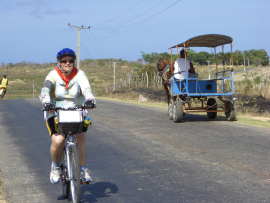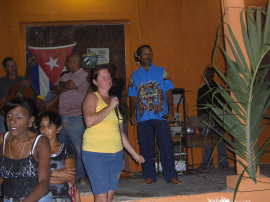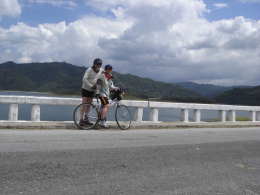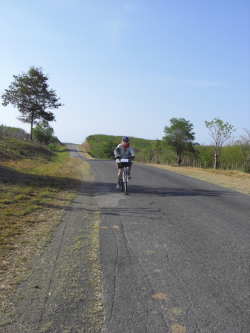Basia and John - Cuba Cycle Challenge 2008
 Last autumn my wife Basia and I read an appeal in The Big Issue for people to volunteer for a sponsored cycle ride in Cuba at the end of April to raise money for The Music Fund for Cuba. The fund is a U.K. registered charity founded in 2001 in memory of Kirsty MacColl, a well known personality in the music scene who had a great interest in Cuban music and culture. Over the years since then the fund has provided musical instruments, educational equipment, dancing shoes and funds towards restoring one of Havana's oldest theatres for use as a training and performance centre. This particular appeal was targeting schoolchildren and specifically a school for blind and visually impaired children. Once we had registered we received a suggested training programme and an itinerary for the challenge.
Last autumn my wife Basia and I read an appeal in The Big Issue for people to volunteer for a sponsored cycle ride in Cuba at the end of April to raise money for The Music Fund for Cuba. The fund is a U.K. registered charity founded in 2001 in memory of Kirsty MacColl, a well known personality in the music scene who had a great interest in Cuban music and culture. Over the years since then the fund has provided musical instruments, educational equipment, dancing shoes and funds towards restoring one of Havana's oldest theatres for use as a training and performance centre. This particular appeal was targeting schoolchildren and specifically a school for blind and visually impaired children. Once we had registered we received a suggested training programme and an itinerary for the challenge.
We had five days of cycling ahead of us with distances varying between 48 and 87 kilometres through coastal areas and mountains in temperatures around thirty degrees and the training schedule suggested we would need to be well prepared. During the winter months it was not easy to motivate ourselves to go out when it was cold and wet so our training mileage was limited. Readers will remember that from September until March it seemed to be dark and wet for most of the time. However we persevered as best we could and counted on our willpower making up for the lack of muscle.
 Meanwhile we set up a web based charity page and sent emails to all our friends asking for support. We organised a couple of musical evenings locally and in Glasgow which were publicised through the internal email facility of the local authority where I work and our fund began to grow. We had not quite reached the target sum by the specified date but we tapped into our own financial resources to make up the difference.
Meanwhile we set up a web based charity page and sent emails to all our friends asking for support. We organised a couple of musical evenings locally and in Glasgow which were publicised through the internal email facility of the local authority where I work and our fund began to grow. We had not quite reached the target sum by the specified date but we tapped into our own financial resources to make up the difference.
At last it was time to pack the bikes in boxes for the journey and set off for London where we would meet up with the rest of the group to fly to Cuba where we spent the first night in an old and rather grand hotel in Havana. Next day we had a morning walking tour of Old Havana before being taken to the starting point of the cycle ride in the foothills of the Escambray mountains. The next day was the first and longest of the challenge through rural Cuba involving many hills and passing through small towns where locals gave us friendly waves and children cheered at the sight of several white cyclists in safety helmets pedalling past. Great care was required as we came across unmarked railway crossings where the tracks were either four inches above or below the road surface or occasional potholes appeared on turning a corner. That and other days gave a real flavour of life in the countryside. From a bicycle you can hear, see and smell what is going on around you and exchange greetings with people as you pass by. Oxen are still used as draught animals in the countryside for ploughing and hauling logs and we even saw a man beginning to cut up a freshly slaughtered pig in his yard. A people short on technology but big on relationships and mutual support.
 There is no doubt that Cuba is a poor and developing country and this is due in no short measure to the continuing trade embargo enforced by the United States of America to undermine the progress of the Cuban Revolution. However, unlike many developing countries, every child in Cuba attends school and the vast majority are able to read and write by the age of six. Every person has ready access to healthcare through a network of doctors, local clinics for minor surgery and regional hospitals for more complex treatment which might involve in-patient care. Everyone also has a monthly allowance of essentials such as rice, beans, milk etc. and non food items such as toothpaste and soap so nobody is starving or unnecessarily ill. The older citizens who are smokers even have a ration of tobacco although this has not been included in allowances generally for some years now because of the dangers to health.
There is no doubt that Cuba is a poor and developing country and this is due in no short measure to the continuing trade embargo enforced by the United States of America to undermine the progress of the Cuban Revolution. However, unlike many developing countries, every child in Cuba attends school and the vast majority are able to read and write by the age of six. Every person has ready access to healthcare through a network of doctors, local clinics for minor surgery and regional hospitals for more complex treatment which might involve in-patient care. Everyone also has a monthly allowance of essentials such as rice, beans, milk etc. and non food items such as toothpaste and soap so nobody is starving or unnecessarily ill. The older citizens who are smokers even have a ration of tobacco although this has not been included in allowances generally for some years now because of the dangers to health.
 At the end of our tour we visited the Abel Santamaria School for blind and visually impaired children in the outskirts of Havana to deliver several large packages of craft materials which had been specifically requested by the staff there as part of the group's general donation. We were introduced by a member of staff from the Ministry of Education and welcomed by the school's director who took us on a tour of classrooms where several children were working. This was, unfortunately, the day after the first of May which is a day of great celebration involving family parties and street celebrations throughout the country. The result being that many children, having been late to bed, were absent from school. It was quite moving to see these children working with outdated equipment and showing off their work with eighteen strangers around them. Towards the end of the visit some of the older pupils entertained us in the school hall with a short musical concert and puppet show. Finally we returned to the director's office where he made a speech in gratitude for the money raised and presented each of the group with a certificate acknowledging our efforts.
At the end of our tour we visited the Abel Santamaria School for blind and visually impaired children in the outskirts of Havana to deliver several large packages of craft materials which had been specifically requested by the staff there as part of the group's general donation. We were introduced by a member of staff from the Ministry of Education and welcomed by the school's director who took us on a tour of classrooms where several children were working. This was, unfortunately, the day after the first of May which is a day of great celebration involving family parties and street celebrations throughout the country. The result being that many children, having been late to bed, were absent from school. It was quite moving to see these children working with outdated equipment and showing off their work with eighteen strangers around them. Towards the end of the visit some of the older pupils entertained us in the school hall with a short musical concert and puppet show. Finally we returned to the director's office where he made a speech in gratitude for the money raised and presented each of the group with a certificate acknowledging our efforts.
All in all it was a very rewarding experience which happened to coincide with a major initiative of the local Council in promoting the interests of children in our own community. A coincidence which emphasises, for me at least, that "the world o'er, a man's a man for a' that" and the bairns are the future of the world and everybody's responsibility.
If I was asked to pick one thing which left the biggest impression on me from the whole trip it would be the courtesy of road users. Traffic in towns moves at the convenience and pace of the horse drawn and pedal powered vehicles and I never heard a horn used aggressively throughout the visit. Some people here might get impatient waiting behind a horse or bicycle in their overpowered car or truck until it is clearly safe to pass but in Cuba the quality of life and respect for your fellow citizens seems more important than the pace of life.





